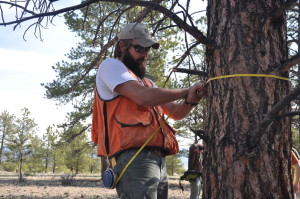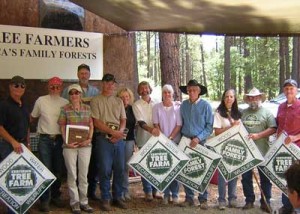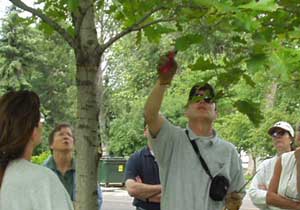Steamboat Springs Field Office – Forest Management & Stewardship
Where lands allow for active management to occur, we can enhance forest resilience to fire, insects and diseases. Forest management also will continue to provide much-needed wood products and help diversify local economies.



What Is A Healthy Forest?
Healthy forests allow for a diverse array of benefits. They provide habitat for many wildlife species, improve water quality, filter pollutants from water and air, enhance outdoor recreational activities, provide wood products and supply jobs that support local economies.
How Does Forest Management Lead to Healthy Forests?
Forest management can fulfill an important role in how we help shape Colorado’s future forests. Where lands allow for active management to occur, we can enhance forest resilience to fire, insects and diseases.
Forest management also will continue to provide much-needed wood products and help diversify local economies. When we maintain a broad array of forest products markets, the economic value they provide assists us in meeting our desired future forest conditions in a cost-effective manner.
This approach will provide diverse forests for tomorrow, and ensure that we continue to receive the wide range of benefits our forests provide.
How Can The Colorado State Forest Service Help?
Every year, the Colorado State Forest Service reaches thousands of Coloradans with timely, relevant forestry materials, education and information. This educational assistance is only one tool we use to provide for the stewardship of Colorado’s forest resources and reduce related risks to life, property and the environment.
To truly meet the intent of our mission, the CSFS uses the best available science and a variety of tools to help determine where comprehensive forest management is most needed and beneficial, including the annual forest health aerial survey and forest health report, field observations, and collaboration with other land management agencies. Colorado’s Forest Action Plan will help guide the CSFS and other forestry stakeholder as we work together to develop a landscape-level approach to leveraging limited resources where they will achieve the greatest benefit.
Wood Products

The Colorado Wood Utilization and Marketing program provides a wealth of resources and expertise to our wood products businesses and users across the state.
Management Practices for Different Forest Types

Colorado’s forest types evolved throughout our six ecoregions with varying sunlight, nutrient, water and elevational adaptations.
Requirements for Colorado’s major tree species are varied, as are the management approaches that are appropriate for these forest types.
For instance, management practices that encourage healthy forest conditions in ponderosa pine in the montane zone will not be appropriate for lodgepole pine, spruce-fir, piñon-juniper or aspen forests. The needs of these forest types are vastly different, and therefore, effective management strategies to encourage healthy forests in these various types also will vary.
Contact your local CSFS field office for assistance in this area.
Lodgepole Pine Management
Lodgepole pine, (Pinus contorta) is a familiar species in the montane and subalpine forests of Colorado’s Rocky Mountains. It grows at elevations between 6,000 and 11,000 feet. As a consequence of the current mountain pine beetle epidemic, many landowners and land managers are concerned about how to actively manage lodgepole pine stands to:
- Treat the dead standing trees killed by the insects
- Protect homes and communities from wildfire
- Ensure that the future forest is better structured to prevent widespread mortality from insect epidemics and wildfire
Gambel Oak Management
Gambel Oak (Quercus gambelii) is a shrub mostly found along the Front Range to southern Colorado. It grows at elevations between 6,000 and 9,000 feet. Management of gambel oak is important because after recurring fires the shrubs can grow into thick clumps. This may decrease the benefits for wildlife or livestock and increase wildfire risk.
Learn More
Piñon-Juniper Management
Piñon-juniper woodlands are widespread in Colorado’s lower elevations, ranging from 4,900 to 8,000 feet on Colorado’s Western Slope and in limited distribution in south-central Colorado and the Eastern Plains. In southeastern Colorado, piñon-juniper ecosystems are found in the canyonlands and adjacent shortgrass prairie ecosystems below the Gambel oak zone.
Learn More
Cottonwood Management
Adapted to thrive on Colorado’s Eastern Plains, in mountain valleys and along riparian areas throughout the state, cottonwoods represent the largest native broadleaf trees in the state, and the most pervasive deciduous trees found at lower elevations.
Learn More
Basic Forest Management Principles
- Forests are dynamic. Other than natural growth and succession, change agents include: forest fires (leading to plant succession), windstorms, diseases, insects, overly dense tree stands, forest thinning and reforestation.
- As a forest matures, individual trees become more or less dominant while others may become overtopped. A tree’s position in a stand has a significant effect on its growth rate and susceptibility to change agents.
- Where trees grow often depends on the characteristics of that tree species. Not all tree species will grow in the same area.
- Different species respond differently to different silvicultural treatments. Silviculture is the art and science of controlling the establishment, growth, composition, health and quality of forests.
- Basal area is the area of a tree cross-section at breast height (4-1/2 ft.). This includes the bark and is expressed in square feet as DBH (diameter breast height).
- Agroforestry involves afforestation and reforestation for windbreaks, increased crop yield, increased water storage, wildlife enhancement, road protection and enhancing the landscape.
- In applying ecological principals to forest management on private land, the owner’s goals and management objectives must be kept in the forefront. A landholder’s management activities are driven by his or her objectives.



